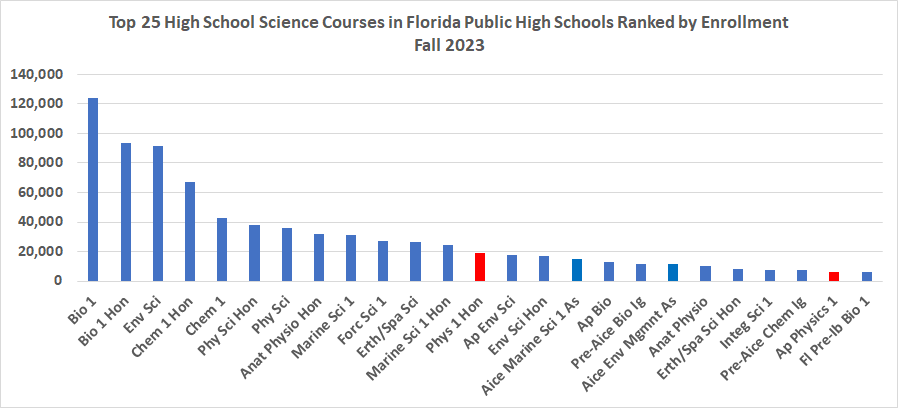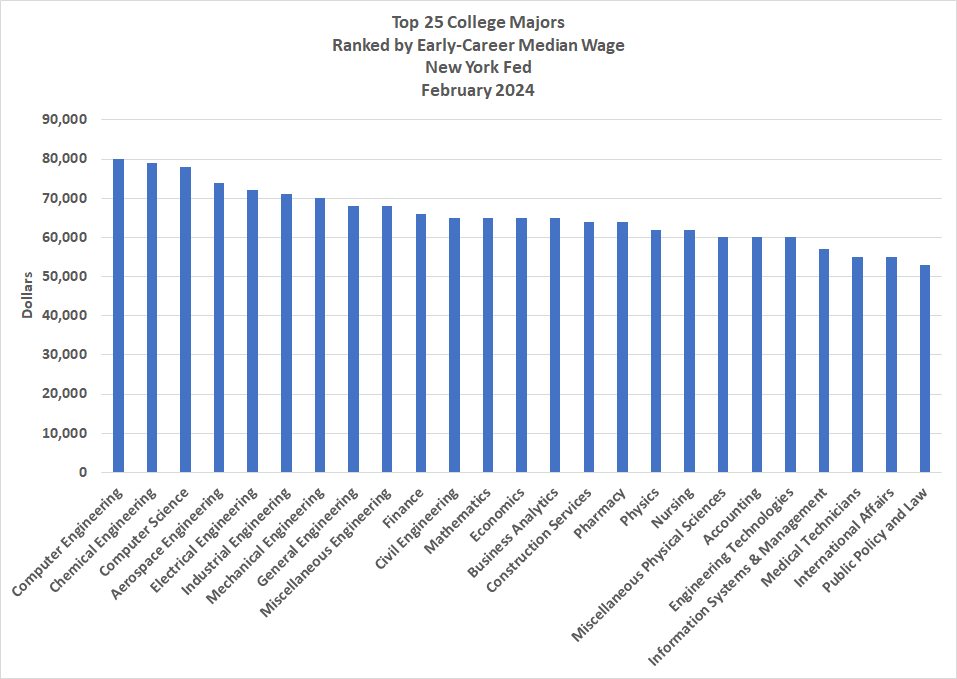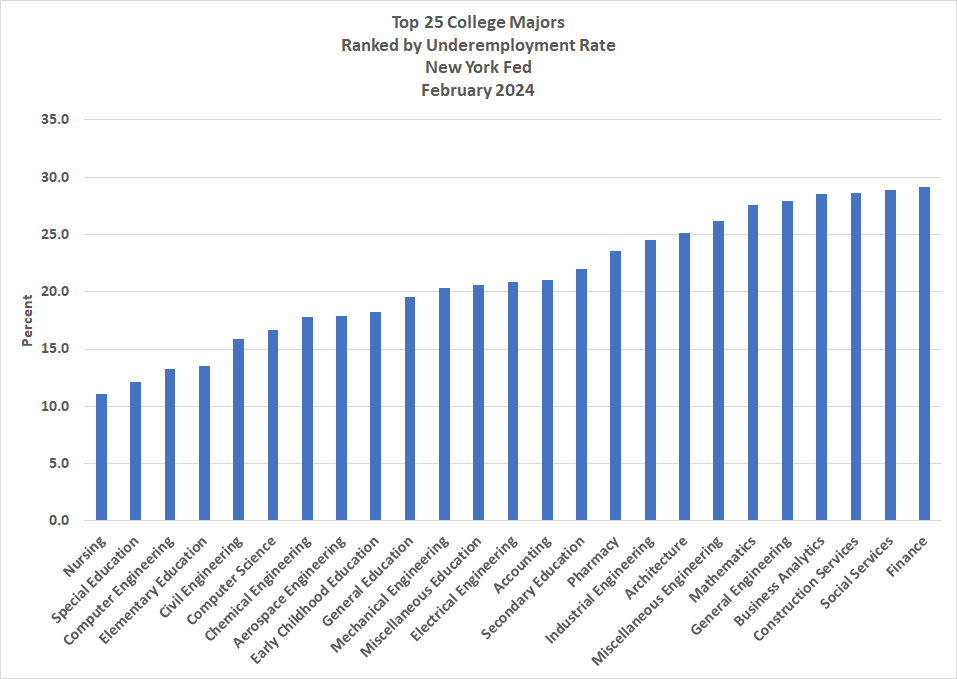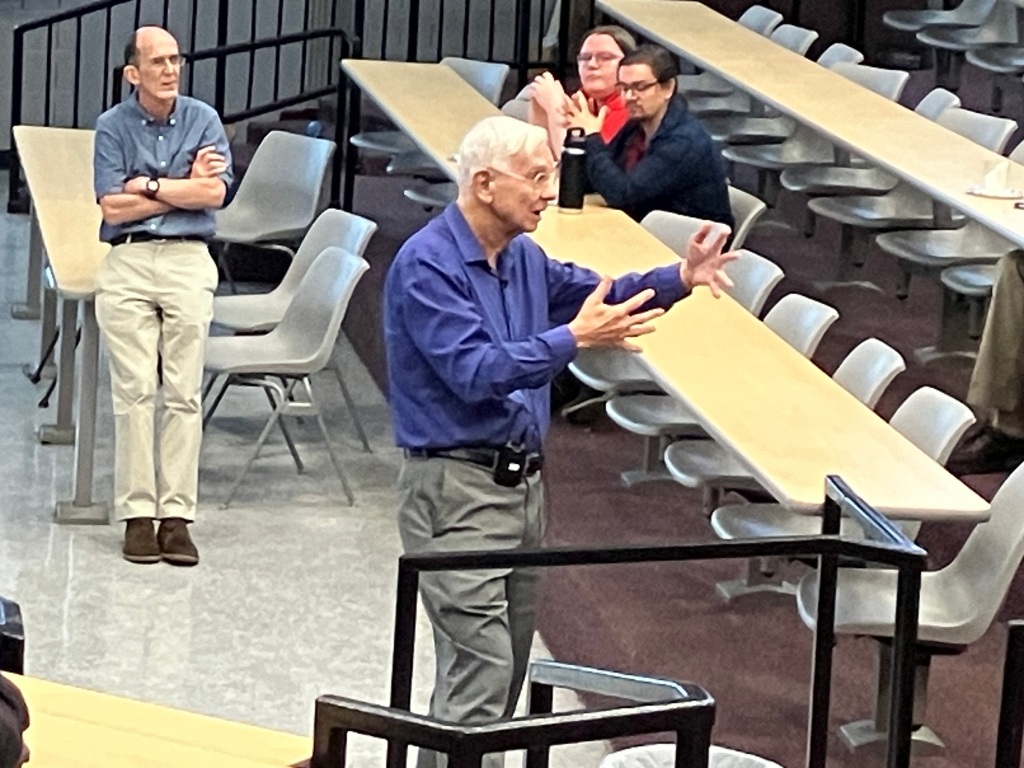Update (Monday, 2:40 pm): The SAT scores I quoted for Bright Futures eligibility were incorrect. I have updated this post with the proper scores.
Only 4.1% of the students enrolled in Florida’s public high schools this past fall were taking physics, so it is certain that fewer than one in five graduates from these high schools have taken a physics course. According to the 2019 National High School Physics Survey conducted by the American Institute of Physics Statistical Research Center, 42% of the national high school graduating class of 2019 had taken at least one physics course. So Florida students are far behind their peers from other states in learning physics in high school.
Florida requires that students in the public high schools take three science courses to graduate. One of those must be a biology course. But in addition to biology, what are students taking? The plot below provides an answer to that question by showing the top 25 science courses in the state’s public high schools ranked by enrollment in the Fall of 2023. The data come from the Florida Department of Education. The red bars show the physics courses that are in the top 25 – Honors Physics 1 and AP Physics 1. Non-Honors Physics did not make the top 25. Interestingly enough, neither did AP Chemistry.
Non-Honors and Honors Biology 1 top the rankings. That is not surprising given the statewide biology graduation requirement. The sum of the enrollments in those two courses is approximately equal to the 200,000 students who graduate from Florida’s public high schools each year. Then enrollments drop off pretty quickly. The Non-Honors Environmental Science course is next, and then Honors and non-Honors Chemistry 1. Enrollment in Honors Physics 1 is more than a factor of three lower than the enrollment in Honors Chemistry 1.
Florida is home to a number of high schools utilizing the dueling European college credit programs, the International Baccalaureate (IB) program and the Advanced International Certificate of Education (AICE) program, which is also known as the Cambridge program. No IB science courses make the top 25 (Pre-IB Biology 1 is ranked 25th, but no college credit-earning IB courses make the list). However, two AS-level AICE courses make the list – Marine Science and Environmental Management. Interestingly enough, of the six AICE AS-level science courses (Biology, Chemistry, Computer Science, Environmental Management, Marine Science and Physics), Marine Science and Environmental Management have the highest international exam failure rates (42.3% and 36.8%, respectively). At 31.0%, Computer Science isn’t far behind. But Biology (20.3%), Chemistry (12.8%) and Physics (13.9%) have much lower failure rates.
Financial incentives to students, teachers and schools drive students into AICE (and IB) science courses. A student who earns an AICE “diploma” by passing six AICE exams (in any subject mix) automatically earns a Bright Futures scholarship, which is Florida’s lottery-funded “merit” scholarship program. The same is true for an IB diploma. Students who do not earn an AICE or IB diploma must achieve qualifying scores on the SAT, ACT or Classic Learning Test (CLT). To earn a scholarship for 100% of tuition and fees, a student must achieve a score that is in the 89th percentile. For the SAT, that is presently 1340. A scholarship for 75% of tuition and fees requires a score in the 75th percentile, which for the SAT is presently 1210. AICE and IB diploma awardees do not have to sweat out standardized tests to earn their scholarships.
If a student passes an AICE exam (or an IB exam), both the student’s teacher and school earn bonuses. There is an extra bit of cash if the student happens to be at a high school earning a “D” or “F” school grade from the FLDOE. In addition, students can earn “acceleration credits” for their schools by passing AICE or IB exams.
The bonus system for both teachers and schools also applies to AP exams. However, the passing rates for most AP math and science exams are significantly lower than the passing rates for most AICE exams.
The bottom line is that a high school in need of resources (and that is all public high schools in Florida) has an incentive to steer students into AICE science courses in which the school’s administration believes that a large number of students will pass the exams.
I visited such a high school last week. It is a large school (more than 3,000 students) in one of the nation’s largest school districts. About two-thirds of the students are classified as economically disadvantaged by the Florida Department of Education (about half statewide are classified as economically disadvantaged). I was told during my visit that the usual science course progression for students in the AICE program is Honors Biology 1 in 9th grade, Honors Chemistry 1 in 10th grade, and AICE Environmental Management and Marine Science 1 courses in 11th and 12th grade (not necessarily in that order). The Fall 2023 enrollments in Honors Biology 1, Honors Chemistry 1, AICE Environmental Management and AICE Marine Science 1 were 287, 209, 163 and 140, respectively. That’s consistent with such a science course progression. The only physics course offered at the school this year is AP Physics 1, which had 18 students in the fall. In 2023, the national pass rate for the AP Physics 1 exam was 45.6%, well below the June 2023 pass rates for AICE Environmental Management (63.2%) and AICE Marine Science 1 (57.7%). In addition, AP Physics 1 requires a level of mathematical competence that is unfortunately less common among Florida students than it is in many other states.
At least there is a physics course offering at the school I visited, which means the school’s administration understands the importance of having that option for students. And the physics teacher there is quite well-qualified. The relatively few physics students are in a good situation.
But the students there who are not taking physics and aspire to attend medical school or pursue other health or STEM careers are putting themselves at a disadvantage. Untangling this problem would mean addressing a system of incentives that seems, for now at least, intractable.























